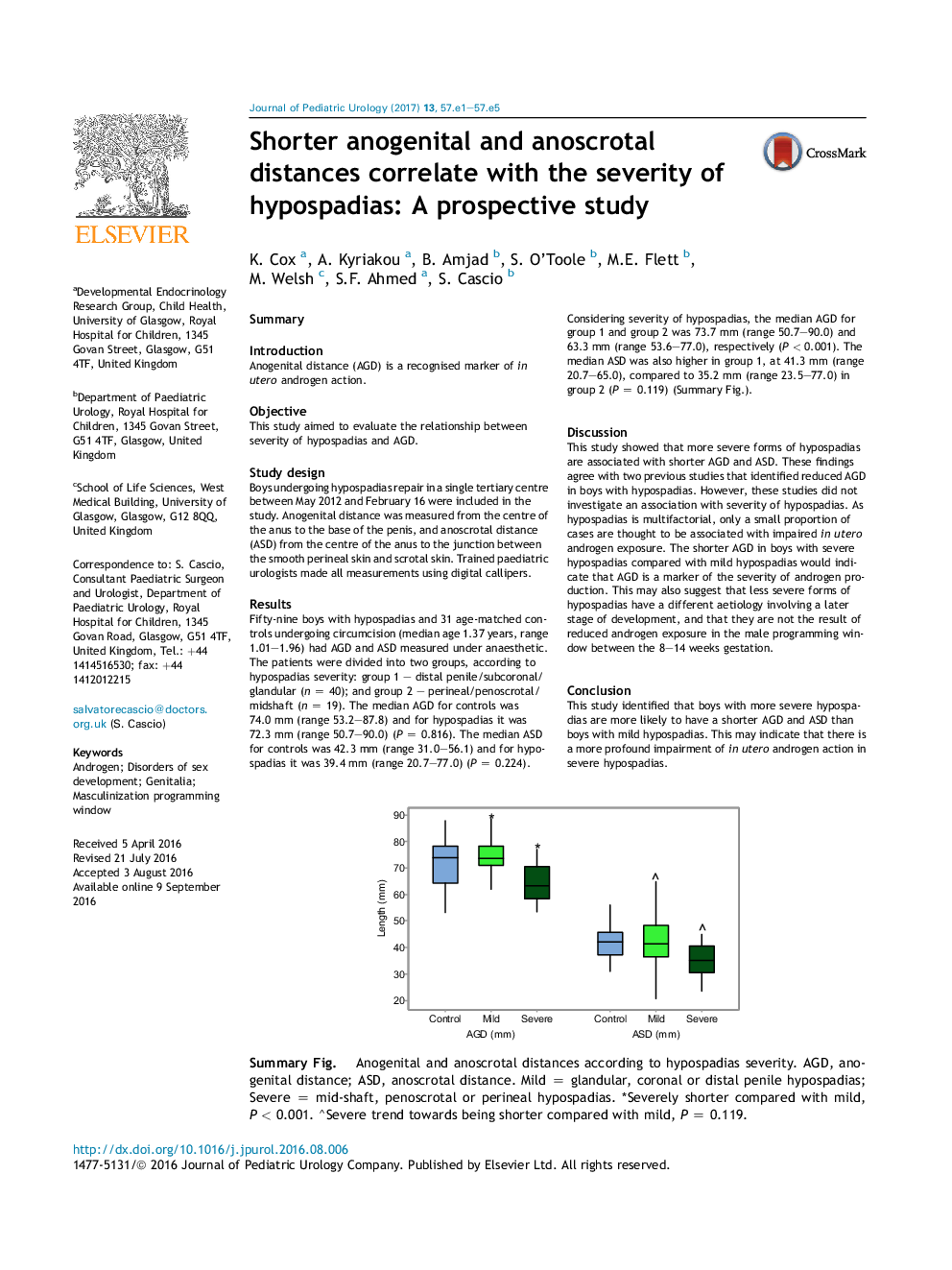| کد مقاله | کد نشریه | سال انتشار | مقاله انگلیسی | نسخه تمام متن |
|---|---|---|---|---|
| 5718661 | 1411255 | 2017 | 5 صفحه PDF | دانلود رایگان |
SummaryIntroductionAnogenital distance (AGD) is a recognised marker of in utero androgen action.ObjectiveThis study aimed to evaluate the relationship between severity of hypospadias and AGD.Study designBoys undergoing hypospadias repair in a single tertiary centre between May 2012 and February 16 were included in the study. Anogenital distance was measured from the centre of the anus to the base of the penis, and anoscrotal distance (ASD) from the centre of the anus to the junction between the smooth perineal skin and scrotal skin. Trained paediatric urologists made all measurements using digital callipers.ResultsFifty-nine boys with hypospadias and 31 age-matched controls undergoing circumcision (median age 1.37 years, range 1.01-1.96) had AGD and ASD measured under anaesthetic. The patients were divided into two groups, according to hypospadias severity: group 1 - distal penile/subcoronal/glandular (n = 40); and group 2 - perineal/penoscrotal/midshaft (n = 19). The median AGD for controls was 74.0 mm (range 53.2-87.8) and for hypospadias it was 72.3 mm (range 50.7-90.0) (P = 0.816). The median ASD for controls was 42.3 mm (range 31.0-56.1) and for hypospadias it was 39.4 mm (range 20.7-77.0) (P = 0.224). Considering severity of hypospadias, the median AGD for group 1 and group 2 was 73.7 mm (range 50.7-90.0) and 63.3 mm (range 53.6-77.0), respectively (P < 0.001). The median ASD was also higher in group 1, at 41.3 mm (range 20.7-65.0), compared to 35.2 mm (range 23.5-77.0) in group 2 (P = 0.119) (Summary Fig.).DiscussionThis study showed that more severe forms of hypospadias are associated with shorter AGD and ASD. These findings agree with two previous studies that identified reduced AGD in boys with hypospadias. However, these studies did not investigate an association with severity of hypospadias. As hypospadias is multifactorial, only a small proportion of cases are thought to be associated with impaired in utero androgen exposure. The shorter AGD in boys with severe hypospadias compared with mild hypospadias would indicate that AGD is a marker of the severity of androgen production. This may also suggest that less severe forms of hypospadias have a different aetiology involving a later stage of development, and that they are not the result of reduced androgen exposure in the male programming window between the 8-14 weeks gestation.ConclusionThis study identified that boys with more severe hypospadias are more likely to have a shorter AGD and ASD than boys with mild hypospadias. This may indicate that there is a more profound impairment of in utero androgen action in severe hypospadias.104Summary Fig.. Anogenital and anoscrotal distances according to hypospadias severity. AGD, anogenital distance; ASD, anoscrotal distance. Mild = glandular, coronal or distal penile hypospadias; Severe = mid-shaft, penoscrotal or perineal hypospadias. *Severely shorter compared with mild, P < 0.001. ËSevere trend towards being shorter compared with mild, P = 0.119.
Journal: Journal of Pediatric Urology - Volume 13, Issue 1, February 2017, Pages 57.e1-57.e5
